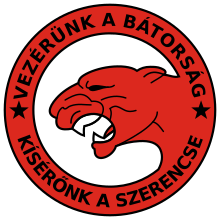Aladár Heppes
Aladár Heppes (born November 20, 1904 in Arad ( Hungary ); † August 15, 1988 ) was a fighter pilot in the Royal Hungarian Air Force and from 1944, as a lieutenant colonel, commander of the air defense of Hungary in World War II and squadron leader.
biography
Heppes was the second born son of a judge. His father fell at the beginning of the First World War . After attending elementary school , Heppes went to the military secondary school in Nagykanizsa and from there to the military high school in Budapest . After his training at the Austro-Hungarian Military Academy , Heppes joined the secret Hungarian air force, as Hungary was not allowed to have any military air forces according to the provisions of the Treaty of Trianon . In 1928 Heppes completed his first solo flight. He then served as a reconnaissance aircraft. In 1935 he switched to a hunting squadron as an operations officer. In 1939, meanwhile with the rank of captain , he joined the I / II as adjutant . Hunting group. After the beginning of the German-Soviet War in June 1941, in which Hungary participated as an ally of Germany, Heppes became the commander of this hunting group. With outdated biplanes type Fiat CR.42 the group took part in fighter-bomber missions. From 1943 the conversion to Messerschmitt Bf 109 aircraft took place . In the spring of 1943, the conversion of the four hunting squadrons under Heppes was completed. The Pumas he named flew missions in the Kharkov area . By early August 1943, Heppes had four aerial victories on this type of aircraft.
With the advance of the Red Army from late autumn 1943, the main task of the Hungarian Air Force increasingly focused on the defense of its own homeland. In order to compensate for the lack of well-trained fighter pilots, Heppes was appointed commander of the pilot school in Tapolca . There he took on tasks in operational training. In March 1944, Heppes was entrusted with setting up a new hunting association. The 101st Hungarian fighter group in Veszprém consisted of four squadrons and comprised about 40 Bf 109 G-6 fighters. The staff consisted of about 500 people. In the following time, Heppes and his group flew mainly missions against US air forces. On May 27, 1944, Heppes was promoted to major . In the following two months he won four more victories. After Romania capitulated to the Soviet Union on August 23, 1944, Heppes was entrusted with the entire air defense of Hungary and a little later promoted to lieutenant colonel. The 101st Royal Hungarian Air Defense Fighter Squadron, now subordinated to him, but renamed, withdrew to the area around Raffelding near Linz by spring 1945 . Due to fuel shortages, operations were rarely carried out during this period. At the end of the war, Heppes capitulated to US troops.
To avoid reprisals from the communist system that came to power in Hungary after the war, Heppes emigrated to the United States. There he ran a design office on the northeast coast.
literature
- Walter A. Musciano: The famous Me 109 and their pilots , Weltbild-Verlag 1995, ISBN 3-89350-557-1
| personal data | |
|---|---|
| SURNAME | Heppes, Aladár |
| BRIEF DESCRIPTION | Hungarian fighter pilot |
| DATE OF BIRTH | November 20, 1904 |
| PLACE OF BIRTH | Arad |
| DATE OF DEATH | August 15, 1988 |
